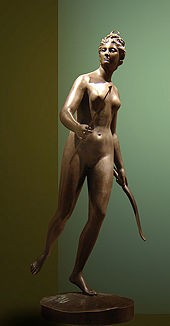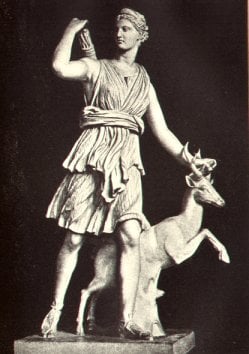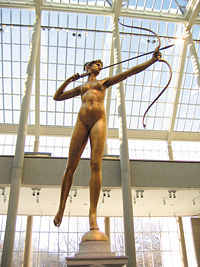Difference between revisions of "Diana (mythology)" - New World Encyclopedia
m |
|||
| Line 2: | Line 2: | ||
In [[Roman mythology]], '''Diana''' was the goddess of the [[hunting|hunt]], in literature the [[Greek deities and their Roman and Etruscan counterparts|equivalent]] of the [[Greek mythology|Greek goddess]] [[Artemis]], though her [[Cult (religion)|cult]] was Italic in origin. The daughter of Zeus and Latona, Diana was born with her twin brother Apollo on the island of Delos. | In [[Roman mythology]], '''Diana''' was the goddess of the [[hunting|hunt]], in literature the [[Greek deities and their Roman and Etruscan counterparts|equivalent]] of the [[Greek mythology|Greek goddess]] [[Artemis]], though her [[Cult (religion)|cult]] was Italic in origin. The daughter of Zeus and Latona, Diana was born with her twin brother Apollo on the island of Delos. | ||
| − | == | + | == Goddess of the hunt== |
| − | Diana was the hunting goddess, associated with wild animals and woodlands. She also later became a [[moon goddess]], supplanting [[Luna (goddess)|Luna]], and was an emblem of [[chastity]]. [[Oak]] groves were especially sacred to her. She was praised in poetry for her strength, athletic grace, distinct beauty and hunting skill | + | Diana was the virgin hunting goddess, associated with wild animals and woodlands. She also later became a [[moon goddess]], supplanting [[Luna (goddess)|Luna]], and was an emblem of [[chastity]]. [[Oak]] groves were especially sacred to her. She was praised in [[poetry]] for her strength, athletic grace, purity, distinct beauty, and hunting skill. |
| − | Diana | + | Etymologically, "Diana" means simply "the Goddess," parallel to the name of Greek goddess [[Dione (mythology)|Dione]] at [[Dodona]], although the two are not related either mythologically of in terms of cult practice. She was goddess of fertility worshiped especially by women seeking seeking conception and healthy delivery. Diana was regarded with great reverence by lower-class citizens and [[slavery|slaves]], and runaway slaves could receive asylum in her temples. |
| + | |||
| + | Diana was also a goddess of domestic animals. As the goddess of the hunt, she may have evolved from an earlier forest deity. Diana also made up a trinity with two other Roman deities: [[Egeria (mythology)|Egeria]] the water nymph, who was her servant and assistant midwife; and [[Virbius]], the woodland god. | ||
| + | |||
| + | Diana was worshiped at a festival on August 13, the date upon which King [[Servius Tullius]] dedicated her shrine on the [[Aventine Hill]] in Rome in the mid-sixth century B.C.E. Being placed on the Aventine, and thus outside the of Rome's sacred boundaries, meant that Diana's cult essentially remained a "foreign" one at this time, like that of [[Dionysus|Bacchus]] (Dionysus). Diana remained in this position and was never officially transferred to Rome as was the case with some other deities. It seems that her cult originated in town of [[Aricia]] near Rome, where her priest, the [[Rex Nemorensis]] ("the king of the grove") remained, by the shores of Lake Nemi. There the simple open-air temple was held in common by the Latin tribes, and legend holds that a new priest replace his predecessor only by slaying him. | ||
[[Image:Houdon-diana.jpg|thumb|left|170px|Diana huntress, by [[Houdon]]. [[Louvre]]]] | [[Image:Houdon-diana.jpg|thumb|left|170px|Diana huntress, by [[Houdon]]. [[Louvre]]]] | ||
| − | + | Diana is sometimes portrayed as accompanied by a deer, as in the ''[[Diana of Versailles]]'', as the patroness of hunting. The deer may also be a reference to the myth of [[Actaeon|Acteon]] (or Actaeon), who saw Diana bathing naked, whereupon Diana transformed him into a stag and set his own hunting dogs to kill him. Some Roman patrons ordered marble replicas of the Anatolian version of "Diana of Ephesus," as the goddess of domestic animals. However, Diana was usually depicted by the Romans in her Greek guise. | |
| + | |||
| + | Worship of Diana is also mentioned in the Bible. In [[Acts of the Apostles]], Ephesian metalsmiths who felt threatened by Saint Paul’s preaching of Christianity, jealously rioted in Diana's defense, shouting “Great is Diana of the Ephesians!” (Acts 19:28, [[New English Bible]]). | ||
| + | |||
| + | == Legacy == | ||
| + | [[Image:Diana by Augustus Saint-Gaudens 01.jpg|right|thumb|200px|''Diana'' (1892 - 93), [[Augustus Saint-Gaudens]]. Bronze, [[Metropolitan Museum of Art]], [[New York City]]]] | ||
| + | Diana's cult has been related in [[Early Modern Europe]] to the cult of [[Nicevenn]] (aka Dame Habond, Perchta, Herodiana, etc.). She was related to myths of a female [[Wild Hunt]], close to the [[Benandanti]]s' struggles against evil [[European witchcraft|witches]]. | ||
| + | |||
| + | Since the [[Renaissance]] the mythic Diana has often been expressed in the visual and dramatic arts, including the opera ''[[L'arbore di Diana]]''. In the sixteenth century, Diana's image figured prominently at the [[Château de Fontainebleau]], in deference to [[Diane de Poitiers]], mistress of two French kings. At [[Palace of Versailles|Versailles]] she was incorporated into the Olympian iconography with which [[Louis XIV of France|Louis XIV]], the Apollo-like "Sun King" liked to surround himself. | ||
| + | |||
| + | There are also references to her in common literature. In Shakespeare's play, Romeo and Juliet, many references are made to Diana. Rosaline, a beautiful woman who has sworn to chastity, is said to have "Dian's wit." Later on in the play, Romeo says, "It is the East, and Juliet is the sun. Arise fair sun, and kill the envious moon." He is saying that Juliet is better than Diana and Rosaline for not swearing chastity. Diana is also a character in the 1876 Leo Delibe ballet 'Sylvia'. The plot deals with Sylvia, one of Diana's nymphs and sworn to chastity and Diana's assault on Sylvia's affections for the shepherd Amyntas. | ||
| + | |||
| + | Both the Romanian word for "[[fairy]]," ''[[zânǎ]]''<ref name="DEX">''[http://dexonline.ro/search.php?cuv=Z%E1%BA%A4N%C4%82 zână]'' in [[DEX]]'98 and [[NODEX]].</ref> and the [[Asturian language|Asturian]] word for "water nymph," ''[[xana]]'', seem to come from the name of Diana. | ||
| + | |||
| + | In [[Jean Cocteau]]'s 1946 film ''[[Beauty and the Beast (1946 film)|La Belle et la Bête]]'' it is Diana's power which has transformed and imprisoned the beast. | ||
| + | |||
| + | |||
| + | [[Image:DianaAndPomona.jpg|thumb|right|200px|[[Pomona]] (left, symbolizing [[agriculture]]), and Diana (symbolizing [[commerce]]) as building decoration]] | ||
| + | |||
| + | ==Modern day== | ||
| + | Diana remains an important figure in some modern mythologies.. Those who believe that prehistoric peoples lived in [[matriarchy|matriarchal societies]] consider Diana to have originated in a [[mother goddess]] worshipped at that time. | ||
| + | |||
| + | Today there is a [[Dianic Wicca|branch of Wicca]] named for her, which is characterized by an exclusive focus on the feminine aspect of the Divine. | ||
| + | |||
| + | In comic book lore, the character of [[Wonder Woman]] who hails from [[Paradise Island]] which is rich in Greek mythology is written to be a descendant of the [[Gods]], and named after the moon goddess, [[Diana]] | ||
| + | |||
| + | In the funeral oration of [[Diana, Princess of Wales]] in 1997, her brother drew an ironic analogy between the ancient goddess of hunting and his sister - 'the most hunted person of the modern age'. | ||
| + | |||
| + | Diana, like many aspects of mythology, is depicted in the [[comic books]] ''[[Asterix]]''. In the Roman temples, many times can be seen in the background a statue of Diana, depicted as a well rounded lady, usually sitting on a stag, who appears to be suffering. | ||
| + | |||
| + | In Italy the old religion of [[Stregheria]] embraced goddess Diana as Queen of the Witches. Witches being the wise women healers of the time. Goddess Diana created the world of her own being having in herself the seeds of all creation yet to come. It is said that out of herself she divided into the darkness and the light, keeping for herself the darkness of creation and creating her brother Apollo, the light. Goddess Diana loved and ruled with her brother Apollo, the god of the Sun. | ||
| + | As time went on, the Earth was created and Diana descended to Earth, as did her brother Apollo. Diana taught magick and witches were born. One night using witchcraft in the form of a cat, His most beloved animal, Diana tricked Apollo. She gained entrance to His chamber where She seduced Him. From this union a daughter was born, goddess Aradia. | ||
| + | Some people see [[Diana Nemorensis]] as a separate person or goddess, but she is the same Roman goddess, with different stories from different points of view, the strega and the Romans had different stories. | ||
| + | |||
| + | ==Notes== | ||
| + | <!--This article uses the Cite.php citation mechanism. If you would like more information on how to add references to this article, please see http://meta.wikimedia.org/wiki/Cite/Cite.php —> | ||
| + | <div class="references-small" style="-moz-column-count:2; column-count:2;"> | ||
| + | <references /> | ||
| + | </div> | ||
| + | |||
| + | == See also == | ||
| + | *[[Diana Nemorensis]] | ||
| + | *[[Wild Hunt]] | ||
| + | |||
| + | ==External links== | ||
| + | {{commons|Artemis}} | ||
| + | * [http://www.liverpoolmuseums.org.uk/picture-of-month/displaypicture.asp?venue=7&id=130 ''Landscape with Diana and Callisto'' painting] | ||
| + | * [http://www.wga.hu/art/d/domenich/diana.jpg ''Diana and her Nymphs'' painting] | ||
| + | <br clear=all> | ||
| + | {{Roman myth (major)}} | ||
| − | + | [[Category:Lunar goddesses]] | |
| + | [[Category:Hunting goddesses]] | ||
| + | [[Category:Nature goddesses]] | ||
| + | [[Category:Childhood goddesses]] | ||
| + | [[Category:Roman goddesses]] | ||
==Notes== | ==Notes== | ||
Revision as of 20:25, 28 August 2008
In Roman mythology, Diana was the goddess of the hunt, in literature the equivalent of the Greek goddess Artemis, though her cult was Italic in origin. The daughter of Zeus and Latona, Diana was born with her twin brother Apollo on the island of Delos.
Goddess of the hunt
Diana was the virgin hunting goddess, associated with wild animals and woodlands. She also later became a moon goddess, supplanting Luna, and was an emblem of chastity. Oak groves were especially sacred to her. She was praised in poetry for her strength, athletic grace, purity, distinct beauty, and hunting skill.
Etymologically, "Diana" means simply "the Goddess," parallel to the name of Greek goddess Dione at Dodona, although the two are not related either mythologically of in terms of cult practice. She was goddess of fertility worshiped especially by women seeking seeking conception and healthy delivery. Diana was regarded with great reverence by lower-class citizens and slaves, and runaway slaves could receive asylum in her temples.
Diana was also a goddess of domestic animals. As the goddess of the hunt, she may have evolved from an earlier forest deity. Diana also made up a trinity with two other Roman deities: Egeria the water nymph, who was her servant and assistant midwife; and Virbius, the woodland god.
Diana was worshiped at a festival on August 13, the date upon which King Servius Tullius dedicated her shrine on the Aventine Hill in Rome in the mid-sixth century B.C.E. Being placed on the Aventine, and thus outside the of Rome's sacred boundaries, meant that Diana's cult essentially remained a "foreign" one at this time, like that of Bacchus (Dionysus). Diana remained in this position and was never officially transferred to Rome as was the case with some other deities. It seems that her cult originated in town of Aricia near Rome, where her priest, the Rex Nemorensis ("the king of the grove") remained, by the shores of Lake Nemi. There the simple open-air temple was held in common by the Latin tribes, and legend holds that a new priest replace his predecessor only by slaying him.

Diana is sometimes portrayed as accompanied by a deer, as in the Diana of Versailles, as the patroness of hunting. The deer may also be a reference to the myth of Acteon (or Actaeon), who saw Diana bathing naked, whereupon Diana transformed him into a stag and set his own hunting dogs to kill him. Some Roman patrons ordered marble replicas of the Anatolian version of "Diana of Ephesus," as the goddess of domestic animals. However, Diana was usually depicted by the Romans in her Greek guise.
Worship of Diana is also mentioned in the Bible. In Acts of the Apostles, Ephesian metalsmiths who felt threatened by Saint Paul’s preaching of Christianity, jealously rioted in Diana's defense, shouting “Great is Diana of the Ephesians!” (Acts 19:28, New English Bible).
Legacy
Diana's cult has been related in Early Modern Europe to the cult of Nicevenn (aka Dame Habond, Perchta, Herodiana, etc.). She was related to myths of a female Wild Hunt, close to the Benandantis' struggles against evil witches.
Since the Renaissance the mythic Diana has often been expressed in the visual and dramatic arts, including the opera L'arbore di Diana. In the sixteenth century, Diana's image figured prominently at the Château de Fontainebleau, in deference to Diane de Poitiers, mistress of two French kings. At Versailles she was incorporated into the Olympian iconography with which Louis XIV, the Apollo-like "Sun King" liked to surround himself.
There are also references to her in common literature. In Shakespeare's play, Romeo and Juliet, many references are made to Diana. Rosaline, a beautiful woman who has sworn to chastity, is said to have "Dian's wit." Later on in the play, Romeo says, "It is the East, and Juliet is the sun. Arise fair sun, and kill the envious moon." He is saying that Juliet is better than Diana and Rosaline for not swearing chastity. Diana is also a character in the 1876 Leo Delibe ballet 'Sylvia'. The plot deals with Sylvia, one of Diana's nymphs and sworn to chastity and Diana's assault on Sylvia's affections for the shepherd Amyntas.
Both the Romanian word for "fairy," zânǎ[1] and the Asturian word for "water nymph," xana, seem to come from the name of Diana.
In Jean Cocteau's 1946 film La Belle et la Bête it is Diana's power which has transformed and imprisoned the beast.
Modern day
Diana remains an important figure in some modern mythologies.. Those who believe that prehistoric peoples lived in matriarchal societies consider Diana to have originated in a mother goddess worshipped at that time.
Today there is a branch of Wicca named for her, which is characterized by an exclusive focus on the feminine aspect of the Divine.
In comic book lore, the character of Wonder Woman who hails from Paradise Island which is rich in Greek mythology is written to be a descendant of the Gods, and named after the moon goddess, Diana
In the funeral oration of Diana, Princess of Wales in 1997, her brother drew an ironic analogy between the ancient goddess of hunting and his sister - 'the most hunted person of the modern age'.
Diana, like many aspects of mythology, is depicted in the comic books Asterix. In the Roman temples, many times can be seen in the background a statue of Diana, depicted as a well rounded lady, usually sitting on a stag, who appears to be suffering.
In Italy the old religion of Stregheria embraced goddess Diana as Queen of the Witches. Witches being the wise women healers of the time. Goddess Diana created the world of her own being having in herself the seeds of all creation yet to come. It is said that out of herself she divided into the darkness and the light, keeping for herself the darkness of creation and creating her brother Apollo, the light. Goddess Diana loved and ruled with her brother Apollo, the god of the Sun. As time went on, the Earth was created and Diana descended to Earth, as did her brother Apollo. Diana taught magick and witches were born. One night using witchcraft in the form of a cat, His most beloved animal, Diana tricked Apollo. She gained entrance to His chamber where She seduced Him. From this union a daughter was born, goddess Aradia. Some people see Diana Nemorensis as a separate person or goddess, but she is the same Roman goddess, with different stories from different points of view, the strega and the Romans had different stories.
Notes
See also
- Diana Nemorensis
- Wild Hunt
External links
| |||||
Notes
See also
- Diana Nemorensis
- Wild Hunt
External links
| |||||
Credits
New World Encyclopedia writers and editors rewrote and completed the Wikipedia article in accordance with New World Encyclopedia standards. This article abides by terms of the Creative Commons CC-by-sa 3.0 License (CC-by-sa), which may be used and disseminated with proper attribution. Credit is due under the terms of this license that can reference both the New World Encyclopedia contributors and the selfless volunteer contributors of the Wikimedia Foundation. To cite this article click here for a list of acceptable citing formats.The history of earlier contributions by wikipedians is accessible to researchers here:
The history of this article since it was imported to New World Encyclopedia:
Note: Some restrictions may apply to use of individual images which are separately licensed.


